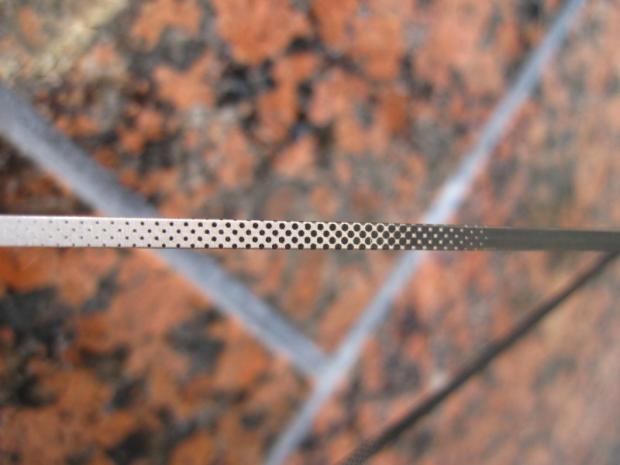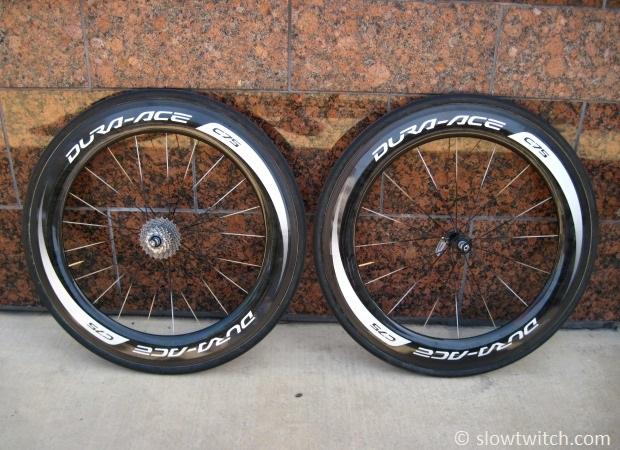This is our review of the latest Dura Ace 9000 wheels from Shimano. While not our usual format, this review isn’t for a single model in the 2013 line-up, but rather the entire line. Shimano was smart in holding a press event in February, at which a group of journalists had the chance to try all of the wheels. Since that time, I’ve also had my hands on a pair of C50 clinchers for long-term riding. We’ll cover all of the pertinent details, including what design features apply to all models, and which are unique to specific models.
To begin, here is the brief overview of the 2013 line:
WH-9000-C24-CL
-24mm deep clincher
-Aluminum braking surface
-20.9mm rim width at braking surface
-$1,199.99
-1,364 grams
-Also available in a tubeless-compatible version
WH-9000-C35-CL
-35mm deep clincher
-Aluminum braking surface
-20.9mm rim width at braking surface
-$1,999.99
-1,488 grams
WH-9000-C35-TU
-35mm deep tubular
-Carbon braking surface
-20.9mm rim width at braking surface
-$2,799.99
-1,362 grams
WH-9000-C50-CL
-50mm deep clincher
-Aluminum braking surface
-22.7mm rim width at braking surface
-$2,199.99
-1,672 grams
WH-9000-C50-TU
-50mm deep tubular
-Carbon braking surface
-24mm rim width at braking surface
-$2,899.99
-1,449 grams
WH-9000-C75-TU
-75mm deep tubular
-Carbon braking surface
-24mm rim width at braking surface
-$3,199.99
-1,545 grams
*All prices include wheel bags, quick release skewers, valve extenders, and rim tape
*Note Shimano PRO disc wheel not sold in US (and we have not ridden it).
Details, details
We originally covered the Shimano 9000 launch event in San Diego, California - HERE.
The event included one heck-of-a-ride up (and down) Palomar Mountain on the first day. The second day was reserved for ‘hot laps’ around Fiesta Island, where we were allowed to try any wheel in the line-up (seen in the photo below).

All of the 9000 wheels share a few common characteristics. First, they all have the same Dura Ace hub internals. We’ve written about these before, and they simply work very well. In the author’s opinion, it is the best lightweight hub on the market, because it is also one of the most weather-resistant hubs on the market. If you do need to service them, you can do so with basic tools; modern Shimano hubs only require two 5mm allen keys for all but the most involved maintenance.

Note that the 11-speed freehub is longer and requires an additional spacer for use with 10-speed cassettes (you must stack it up with an existing 1mm 10-speed cassette spacer). Shimano includes this with all 9000-series wheels.

Next, all of the new wheels include a new version of Shimano’s Dura Ace quick release skewer:

While not the lightest skewers on the market, but they offer a very secure hold and simple operation.
Next, we’ll look at spoke lacing. All front wheels feature radial lacing, so no oddballs there. It’s the rears that are unique. The C35, C50, and C75 wheels feature what Shimano calls OptBal 2:1 lacing, seen here:

This design features two spokes on the right side for every one on the left side, for a total of 21 spokes (14:7). This does a very good job of evening out tension between the left and right side of the rear wheel. On most wheels (with an even number of spokes on both sides), the spoke tension on the non-drive side is significantly lower than the drive side, leading to an increased chance in spoke breakage. 2:1 lacing means you have half as many spokes on the left to do the same amount of work, so the tension on these spokes – you guessed it – goes up. Shimano also claims that the even tension leads to better ride feel, better wheel tension over time, and improved stiffness. Unfortunately, the OptBal lacing also requires a stronger rim, so the shallow section C24 relies on a more traditional lacing pattern.
The spokes themselves are new for 2013, and very unique:

Towards the outside of the wheel, the spokes are silver. Towards the hub, they are black. In between, you get the ‘digital fade’ effect, seen above. According to Shimano’s Wayne Stetina, they actually anodize the entire spoke to black, and then use a laser to remove anodize for the silver portion.
The biggest news for the 9000-series wheels (at least in the world of triathlon) is that Shimano has finally jumped on the wider-is-better bandwagon. It’s no secret by now – wider rims allow us to use wider tires with less aero penalty than a wide tire on a narrow rim. My C50 clincher pair measured 22.7mm at the braking surfaces, and has a 17mm inner width. Shimano USA recommends a minimum of a 23mm tire, but encourages the use of 25mm. The tubular version of the C50 and C75 are reported to be 24mm wide at the braking surfaces, but I haven’t measured them myself to confirm.
Keep in mind, however, that this new rim width only applies to the C50 and C75 products. The C24 and C35 remain with outer rim widths of 20.9mm. Inner rim width on the clinchers sits at 15mm (or ISO 15-622). My guess is that these wheels stayed narrow to hit weight targets for the road cycling crowd, who tend to be more weight-conscious than triathletes.
Regardless of rim width, Shimano recommends a conservative maximum pressure of 8 bar (116psi) for the clinchers.

A small but important detail – deep-section Shimano wheels include their excellent valve extenders. They have a very rough section that mimics the threads of a normal presta valve, for a good ‘bite’ by your pump:

Ride Impressions
Now that we’ve covered most of the basics, I’ll share my experiences with each of the wheels.
C24 and C35 clinchers
I rode both of these wheels at the San Diego press event; both shod in 23mm Michelin Pro 4 Service Course tires. I rode the C24’s for the first day’s epic ride up Palomar Mountain, and the C35’s for a couple laps around Fiesta Island on day two.

These wheel sets both behaved as-expected. They’re stable, predictable, and get the job done. While many other manufacturers have gone to carbon clinchers (with carbon braking surfaces), Shimano has stayed with aluminum. According to Shimano staff, the big increase in price and small weight savings are not worth moving to full-carbon. Personally, I think there’s a larger story – the braking feel and power of aluminum braking surfaces. Put simply, it’s really good. Combined with the Dura Ace 9000 calipers, my ride down Palomar was safe, swift, and predictable. I’ve ridden plenty of wheels with carbon braking surfaces (along with a host of pads and calipers), and I’ve yet to find something that trumps an alloy wheel for feel, modulation, power, and noise (or lack thereof). If you’ve never ridden down a serious mountain pass, it can be hard to appreciate the difference between an ‘okay’ rim and brake pairing, and an outstanding one.
C50 clincher
I didn’t bother riding the C50 clinchers while at Shimano’s hosted event, but rather had a pair to take home with me for long-term testing.

I also rode and reviewed their 2012 model, so I put together a few comparison shots. The most notable difference is the rim width; the 2013 grew by 2mm on the inside, and 1.8mm on the outside.

This photo shows the 2012 C50 (left) compared to the 2013 model (right):

Also note that the 2013 changed to internal spoke nipples. My guess is that this was done for aesthetic reasons, but the mechanical side of me wishes they hadn’t.
I also noticed that the inner edge of the rim (where the spokes enter) seems a little bit sharper on the 2013 model:

I actually intended to ride these wheels while at the Shimano event, but was unable. Why? They were shod in 25mm-wide Michelin Pro 4’s. Those tires seem to run large, and when combined with the wide rim, they looked like they must have been 27mm wide. Unfortunately, I was not able to get a measurement at the time – and my borrowed Colnago had insufficient chainstay clearance to fit the big tires. With my long-term test wheels, I mounted up a set of 25mm Continental GP4000 S tires, and they measured 26.0mm edge-to-edge at 90psi.
C50 and C75 tubular
I rode both of these wheels in various combinations for multiple laps around Fiesta Island. For the first few laps, I rolled dual 50’s with 23mm Vittoria Corsa tires:

The first thing I noticed was how good the braking felt. I feathered the brakes… and stomped on them. Combined with Shimano’s blue carbon pad, they felt outstanding. While I still prefer aluminum rims, these set a new standard for me in carbon braking. Fortunately or unfortunately, we didn’t get any rain during our ride, so I cannot comment on wet braking performance.

Next, I strapped on the dual big-boy C75s:

After spending the previous day on shallow C24s, these things felt huge. Anyone who has immediately swapped between training wheels and deep-section carbon tubulars knows that feeling – the big wheels sound hollow… and feel fast.
I was glad to find that the C75s felt stable for such a deep wheel; this likely has to do with the new wide rim. They didn’t feel as lively as the C50’s, but are certainly the aero choice in the line-up. The C75’s braking surface felt identical to the C50, which is to say – very good.
Summary
Shimano has come a long way in wheels. While not perfect (no wheel is), they’re now a legitimate player in the aero game.
…but how aero? Where are the graphs, charts, and grams-of-drag? This is, perhaps, Shimano’s Achille’s heel. In a world of marketing claims and hype, Shimano is decidedly tight-lipped about ALL of their products. At the launch event, we were shown an aero graph, detailing ‘drag’ on the Y-axis and ‘yaw’ on the X-axis – pretty standard, right? The only problem was that the scale was not labeled on the Y-axis, nor was the protocol detailed. Where was the test done? Was it wheel-only? Wheel-and-frame? Which tires were used? All we saw was that Shimano wheels had ‘lower drag’ than all competitors (who were not named). I don’t know about you, but this doesn’t pass my smell test.
What I can say with confidence is that the new 9000-series C50 and C75 are most certainly faster than the previous 7900 models, and likely in the ballpark with other wheels of similar width and depth. With the proliferation of wind tunnels, CFD, and all of the data put out from various tests, it’s becoming easier to spot features that are fast – or at least we can guess are fast with a reasonable degree of confidence.
Functionally, the wheels are terrific. They excel in areas that many feature-packed competitors do not – namely hub reliability, braking, and general build quality. The glaring omission in the product line that I’d love to see is a C75 clincher for us triathletes, and a couple options in 650c. With those, they’d have all of the bases covered, and could really start to chip away at a big slice of market share.



